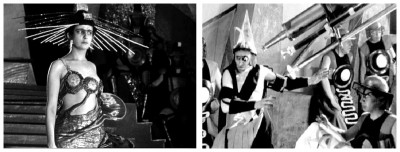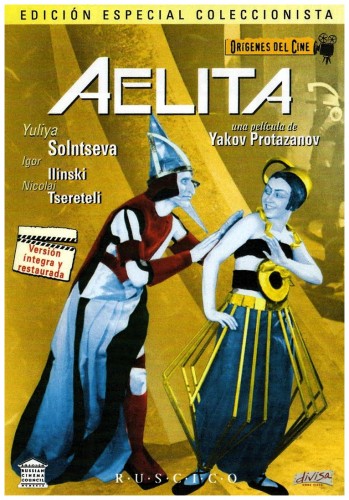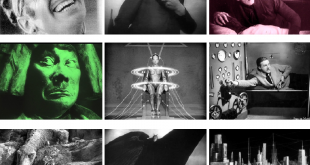“This is called the first Soviet science fiction film because of its ‘futuristic’ sets on Mars, although most of it takes place in Moscow. The movie is set at the beginning of the NEP (New Economic Policy) in December 1921. A mysterious radio message is beamed around the world, and among the engineers who receive it are Los, the hero, and his colleague Spiridonov. Los is an individualist dreamer. Aelita is the daughter of Tuskub, the ruler of a totalitarian state on Mars in which the working classe are put into cold storage when they are not needed. With a telescope, Aelita is able to watch Los. As if by telepathy, Los obsesses about being watched by her. After some hugger-mugger involving the murder of his wife and a pursuing detective, Los takes the identity of Spiridonov and builds a spaceship. With the revolutionary Gusev, he travels to Mars, but the Earthlings and Aelita are thrown into prison by the dictator. Gusev and Los begin a proletarian uprising, and Aelita offers to lead the revolution, but she then establishes her own totalitarian regime. Los is shocked by this development and attempts to stop Aelita, and then reality and fantasy become confused, and Los discovers what has really happened.” (courtesy IMDB)
REVIEW:
August Lumière and his brother Louis Lumière gave the first public demonstration of their ‘cinematography machine’ in Paris in 1895. Seven years later Georges Méliès made A Trip To The Moon (1902), which is probably the first film actually based – however loosely – on the work of a science fiction author. Five years later he applied the same treatment to Jules Verne‘s 20,000 Leagues Under The Sea (1907) although it’s doubtful that the illustrious author would have approved of the half-naked sea nymphs. In England science fiction was treated a little more seriously in Charles Urban‘s The Airship Destroyer (1909), which proved popular and prompted two sequels: The Aerial Anarchists (1911) and The Pirates Of 1920 (1911). In America the Edison company had made the first version of Frankenstein (1910) but, after this first flurry, science fiction cinema fell quiet for the next few years until the ‘big ticket’ of 1916 arrived, none other than a serious attempt to remake 20,000 Leagues Under The Sea (1916).
 Meanwhile in Russia, science fiction was being used for a much more serious purpose – to spread the word of Karl Marx to Mars. Aelita Queen Of Mars (1924) is based on a novel by Alexei Tolstoy, and concerns a Moscow engineer named Los (Nikolai Tsereteli) who is dissatisfied with his life on Earth and dreams of traveling to other worlds and of a beautiful woman named Aelita waiting for him. Upon receiving a mysterious radio message from Mars, he decides to pose as a rocket scientist and plans to build a machine which will take him to Mars. Suspecting his wife Natasha (Valentina Kuindzhi) of having an affair with his next door neighbour, he shoots her during a jealous quarrel and then flees his house, intending to leave for Mars immediately. He eventually makes the journey accompanied by two men: Kravtsov (Igor Ilyinsky) is a detective after Los for the murder of his wife, and a cheerful Red Army soldier named Gusev (Nikolai Batalov) who wants to take the revolution to Mars.
Meanwhile in Russia, science fiction was being used for a much more serious purpose – to spread the word of Karl Marx to Mars. Aelita Queen Of Mars (1924) is based on a novel by Alexei Tolstoy, and concerns a Moscow engineer named Los (Nikolai Tsereteli) who is dissatisfied with his life on Earth and dreams of traveling to other worlds and of a beautiful woman named Aelita waiting for him. Upon receiving a mysterious radio message from Mars, he decides to pose as a rocket scientist and plans to build a machine which will take him to Mars. Suspecting his wife Natasha (Valentina Kuindzhi) of having an affair with his next door neighbour, he shoots her during a jealous quarrel and then flees his house, intending to leave for Mars immediately. He eventually makes the journey accompanied by two men: Kravtsov (Igor Ilyinsky) is a detective after Los for the murder of his wife, and a cheerful Red Army soldier named Gusev (Nikolai Batalov) who wants to take the revolution to Mars.
 Once on Mars, Los becomes romantically involved with the Martian queen Aelita (Yuliya Solntseva), but her Prime Minister Tuskub (Konstantin Eggert) has Los and his companions imprisoned in the caves where the Martian slaves are kept. With the help of Aelita’s servant girl, Gusev escapes and instigates an uprising of the slaves. But just when success seems assured they are betrayed, to Los’s horrified amazement, by Queen Aelita, which only goes to prove that a good Russian should never trust an aristocrat, no matter how beautiful she may be. So great is his shock that he wakes up to find himself in a Moscow railway station. It had, of course, all been a dream. Returning home he finds his wife is unhurt and that she hadn’t been carrying on with his neighbour after all. Once again content to be a part of the Soviet paradise on Earth, he burns all the plans for his invention and returns to his normal life.
Once on Mars, Los becomes romantically involved with the Martian queen Aelita (Yuliya Solntseva), but her Prime Minister Tuskub (Konstantin Eggert) has Los and his companions imprisoned in the caves where the Martian slaves are kept. With the help of Aelita’s servant girl, Gusev escapes and instigates an uprising of the slaves. But just when success seems assured they are betrayed, to Los’s horrified amazement, by Queen Aelita, which only goes to prove that a good Russian should never trust an aristocrat, no matter how beautiful she may be. So great is his shock that he wakes up to find himself in a Moscow railway station. It had, of course, all been a dream. Returning home he finds his wife is unhurt and that she hadn’t been carrying on with his neighbour after all. Once again content to be a part of the Soviet paradise on Earth, he burns all the plans for his invention and returns to his normal life.
 Aelita was directed by Yakov Protazanov, a leading Russian filmmaker before the revolution who had emigrated to Paris in 1917, where he stayed for a few years, making several films. He decided to return to Russia in the early twenties, and Aelita was one of his first projects after his return. The film was coolly received by the Russian critics who didn’t consider it ‘artistic’ enough, but it was popular with the Russian public and many baby girls born that year were named Aelita despite the aristocratic connotations. While very popular at first, the film later fell out of favour with the Soviet government and was thus very difficult to see until after the Cold War.
Aelita was directed by Yakov Protazanov, a leading Russian filmmaker before the revolution who had emigrated to Paris in 1917, where he stayed for a few years, making several films. He decided to return to Russia in the early twenties, and Aelita was one of his first projects after his return. The film was coolly received by the Russian critics who didn’t consider it ‘artistic’ enough, but it was popular with the Russian public and many baby girls born that year were named Aelita despite the aristocratic connotations. While very popular at first, the film later fell out of favour with the Soviet government and was thus very difficult to see until after the Cold War.
 This is probably the first full-length movie to involve space travel, and is best remembered for the cubist-looking sets and costumes designed by Aleksandra Ekster and Isaak Rabinovich, whose influence can be seen in a number of later films, in particular Metropolis (1926) and the Flash Gordon serials, and plot was later loosely adapted for Flight To Mars (1951). The art design is incredibly complicated for its time: Spokes radiate from the queen’s hat, doors open like camera apertures, staircases that start in one direction and then twist back in other directions, and Aelita’s servant wears a special spiral-shaped hat that seems to radiate from her forehead and sweep around her head. This highly stylised form of design helps to suggest much more than what actually happens on the screen.
This is probably the first full-length movie to involve space travel, and is best remembered for the cubist-looking sets and costumes designed by Aleksandra Ekster and Isaak Rabinovich, whose influence can be seen in a number of later films, in particular Metropolis (1926) and the Flash Gordon serials, and plot was later loosely adapted for Flight To Mars (1951). The art design is incredibly complicated for its time: Spokes radiate from the queen’s hat, doors open like camera apertures, staircases that start in one direction and then twist back in other directions, and Aelita’s servant wears a special spiral-shaped hat that seems to radiate from her forehead and sweep around her head. This highly stylised form of design helps to suggest much more than what actually happens on the screen.
 However, Aelita is much more valuable as a daringly objective look at city life under socialisation and communism. Life on Mars mimics life on Earth, and before long the Martian Union of Soviet Socialist Republics stages a major revolution against the upper class and all hell breaks loose. The film takes a political stance even in its depiction of the former aristocrats coping in a Soviet community, and they are portrayed negatively albeit with a touch of sympathy. Ultimately, Aelita sets the tone for future Soviet science fiction films by using the genre as a metaphor to visualise more psychological and down-to-earth issues. And it’s with that thought in mind I’ll ask you to please join me again next week when I have another opportunity to give your cinematic sensibilities a damn good thrashing with the ugly stick for…Horror News! Toodles!
However, Aelita is much more valuable as a daringly objective look at city life under socialisation and communism. Life on Mars mimics life on Earth, and before long the Martian Union of Soviet Socialist Republics stages a major revolution against the upper class and all hell breaks loose. The film takes a political stance even in its depiction of the former aristocrats coping in a Soviet community, and they are portrayed negatively albeit with a touch of sympathy. Ultimately, Aelita sets the tone for future Soviet science fiction films by using the genre as a metaphor to visualise more psychological and down-to-earth issues. And it’s with that thought in mind I’ll ask you to please join me again next week when I have another opportunity to give your cinematic sensibilities a damn good thrashing with the ugly stick for…Horror News! Toodles!
 Horror News | HNN Official Site | Horror Movies,Trailers, Reviews
Horror News | HNN Official Site | Horror Movies,Trailers, Reviews







